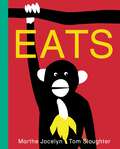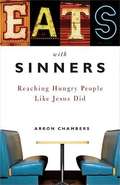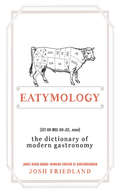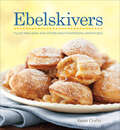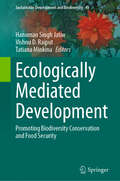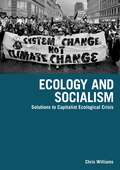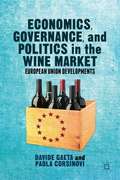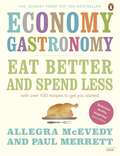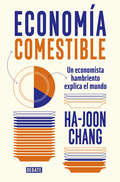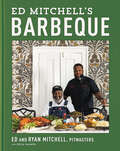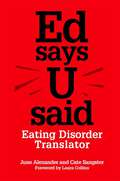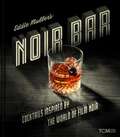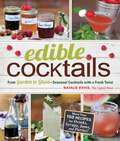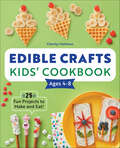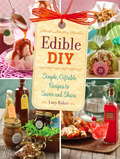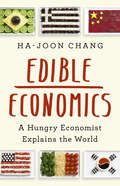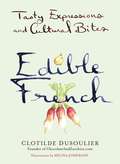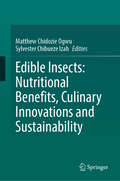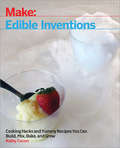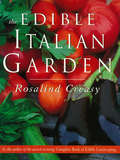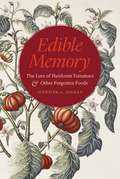- Table View
- List View
Eats
by Marthe JocelynWith a fresh cast of animal characters — and what they eat — the creative team of Marthe Jocelyn and Tom Slaughter has produced another work in their award-winning series for very young book and art lovers. Marthe Jocelyn’s simple concept of matching creatures — familiar and unusual — with their favorite foods is brought to life by the sparkling colors and masterfully cut paper shapes of Tom Slaughter’s illustrations; a first taste of modern art. And the surprise final picture makes a satisfying dessert.Previous titles have received acclaim from Japan to Denmark, from France to Mexico. Enhancing a child’s visual and verbal vocabulary, Eats makes a joyful addition to the collection.
Eats with Sinners: Reaching Hungry People like Jesus Did
by Arron ChambersIn Jesus' day, eating with someone acknowledged that person as an equal. Religious leaders considered it unthinkable for a Jewish teacher to eat with common people. But Jesus cared more about saving souls than saving face. So who are you eating with? Eats with Sinners introduces a biblical model for evangelism-building relationships like Jesus did, one meal (or cup of coffee) at a time. * Each of 13 chapters concludes with a "Meal Plan," which contains questions and directives designed to give individual readers or small group members the opportunity for personal reflection and practical application of the principles outlined in each chapter. * Fun sidebars scattered throughout the book feature recipes, meal traditions in Jesus' day, and case studies.
Eatymology
by Josh FriedlandDo you like your garlic Goodfellas thin? Have you ever been part of a carrotmob? Why are bartenders fat washing their spirits (and what does that even mean?)Eatymology demystifies the most fascinating new food words to emerge from today's professional kitchens, food science laboratories, pop culture, the Web, and more. With 100 definitions, illustrations, and fun food facts and statistics on everything from bistronomy to wine raves, Eatymology shows you why it's absolutely imperative to adopt a coffee name and what it means to be gastrosexual, and is the perfect gift for everyone from foodiots to brocavores.
Ebelskivers: Filled Pancakes and Other Mouthwatering Miniatures
by Kevin CraftsOver 40 mouthwatering recipes for the Danish-style pancakes, ranging from traditional to whimsical and everything in between. Originally from Denmark, ebelskivers (pronounced &“able-skeevers&”) are snacks or desserts traditionally served during holidays and at celebrations. Today, cooks offer these puffy, sphere-shaped pancakes with a wide range of sweet and savory toppings and fillings, varying them in countless creative ways. Making ebelskivers requires little more than ingredients you probably already have on hand—milk, eggs, flour—and a special seven-welled pan that forms the pancakes&’ unique shape. Everything you need to know about making these treats is here: from mixing the batter; to cooking and filling the pancakes; to tips for creating perfect ebelskivers every time. Filled with luscious photographs and more than forty tempting recipes—plus recipes for toppings, sauces, and glazes—this book will provide endless inspiration for any occasion. Served any time of day, these delicious recipes will change the way you look at pancakes forever!
Ecofeminist Approaches to Early Modernity
by Jennifer Munroe Rebecca LarocheChallenges the notion of how early modern women may or may not have spoken for (or even with) nature. By focusing on various forms of 'dialogue,' these essays shift our interest away from speaking and toward listening, to illuminate ways that early modern Englishwomen interacted with their natural surroundings.
Ecologically Mediated Development: Promoting Biodiversity Conservation and Food Security (Sustainable Development and Biodiversity #41)
by Hanuman Singh Jatav Tatiana Minkina Vishnu D. RaiputThis edited volume addresses the critical need to balance biodiversity preservation with ensuring a nutritious and ample food supply for the growing global population. It emphasizes how conserving biodiversity enhances agricultural resilience, promotes sustainable food production, and safeguards food security for present and future generations. The book explores the complex interdependence between biodiversity and food security, identifying both challenges and threats, presenting solutions and strategies, and examining the roles of policies, governance, regulations, and international agreements. It highlights the importance of fostering research and raising awareness to promote sustainable agricultural practices, biodiversity conservation, and equitable resource access essential for long-term food security. The book includes real-world case studies and examples from different regions to demonstrate successful initiatives and the impact of biodiversity conservation on local food systems. This book provides a platform for researchers, conservationists, and policymakers to exchange knowledge and ideas on integrating biodiversity conservation into food security initiatives. It is a compilation of information by the experts and will be useful for researchers in the fields of botany, agriculture, nutrition, policy making and biotechnology.
Ecology and Socialism
by Chris WilliamsAround the world, consciousness of the threat to our environment is growing. The majority of solutions on offer, from using efficient light bulbs to biking to work, focus on individual lifestyle changes, yet the scale of the crisis requires far deeper adjustments. Ecology and Socialism argues that time still remains to save humanity and the planet, but only by building social movements for environmental justice that can demand qualitative changes in our economy, workplaces, and infrastructure.Chris Williams is a longtime environmental activist, professor of physics and chemistry at Pace University, and chair of the science department at Packer Collegiate Institute. He lives in New York City.
Economics of Food Retailing
by Daniel I. PadbergThe primary goal in this presentation is to carry the available economic data on food retailing through to logical conclusions on industry performance. The Food Commission could not agree on an interpretation of these data--both majority and minority members showing a strong propensity to political positions of long standing. The large size and importance of the food retailing industry and its proximity to consumers cast this industry inevitably and eternally in the light of public view, political curiosity, and increasing governmental regulation. This vulnerability identifies the need for a clear understanding of the retailing market structure, competitive behavior, and the kind of social performance which grows therefrom..
Economics, Governance, And Politics In The Wine Market
by Davide Gaeta Paola CorsinoviThe global wine industry is a continually modifying market impacted by financing, culture, and politics. Economics, Governance, and Politics in the Wine Market analyzes recent developments in European Agriculture policies on wine legislation and market trend orientation between political power and market structure.
Economy Gastronomy: Eat well for less
by Allegra McEvedy Paul MerrettLearn how to eat better and spend less with deliciously easy recipes 'Delicious, thrifty, inspiring' GUARDIAN Featuring over 100 mouth-watering recipes and practical tips, Economy Gastronomy will help you to cook simple, better food, and along the way save you a lot of money_______With this essential cookery companion, you will learn how to . . . - Get two, or even three, meals out of one basic ingredient - Turn leftovers into new and exciting dishes - Stock your cupboards so there's always a meal in the house - Shop seasonally, freeze and store food - Plan your meals and shrink your food bills With breakfasts, lunch, dinner, snack and treat ideas, you'll be making luxurious meals without spending a fortune or discarding surplus food in no time. Recipes include: - Caramelised onion and Cheshire cheese tart - Onion bhajis, tarka dahl and almond rice - Spinach, ham and ricotta gnocchi - Chinese-style crispy duck Filled with money-saving hacks and no-nonsense recipes, Economy Gastronomy will teach you how to use and spend less, without scrimping on flavour.
Economía comestible: Un economista hambriento explica el mundo
by Ha-Joon ChangUn festín de ideas económicas alternativas de la mano del autor de 23 cosas que no te cuentan sobre el capitalismo. «El único libroque he leído que me ha hecho reír, salivar y reevaluar mis ideas sobre economía, todo al mismo tiempo. Un volumen divertido, profundo y apetitoso».Brian Eno Cuando, en los años ochenta, el economista Ha-Joon Chang aterrizó por primera vez en Reino Unido desde Corea del Sur, se encontró con un país que comenzaba a salir de la insípida dieta inglesa y a experimentar con los sabores del resto del mundo. Eraun trayecto inverso al que estaba recorriendo la economía, cada vez más acomodada en una única escuela. Su nuevo y esperado libro, Economía comestible, demuestra con ejemplos claros y sabrosos que del mismo modo que esesencial abrirse a las diversas tradiciones culinarias también lo es disponer de una amplia variedad de perspectivas económicas. En este fascinante y delicioso volumen, Chang convierte en apetecibles todo tipo de ideas económicas, explicándolas a través de algunos ingredientes y recetas de diferentes lugares del planeta. Así, el chocolate puede ser una dulce adicción, pero aporta emocionantes ideas sobre las economías posindustriales del conocimiento; y mientras que la okra hace que el gumbo del sur de Estados Unidos tengauna suavidad que derrite el corazón, también remite a la enmarañada relación entre el capitalismo y la libertad. Desde el coste oculto del trabajo del hogar hasta el lenguaje engañoso del libre mercado, mientras cocina platos de todo el mundo, como el sándwich favorito de Elvis, las gambas al ajillo españolas y el dotorimuk coreano, este irresistible divulgador sirve un festín de ideas audaces fácil de digerir y con el que cambiar el mundo. La crítica ha dicho:«Excelente. Chang lleva dos décadas esforzándose por ofrecer una alternativa al neoliberalismo. Ahora ha alcanzado la cima de su propósito».Dan Davies, The Guardian «Un fascinante estofado de comida, historia y economía».Tim Spector «Una brillanteréplica al mito de que los legisladores pueden sobrevivir en simple programa neoliberal. Economía comestible es un festín portátil de ideas económicas alternativas envueltas en ingeniosas historias sobre comida de alrededor del mundo. Ha-Joon Chang demuestra una vez más que es uno de los economistas en activo más apasionantes».Owen Jones «Ha-Joon Chang lo ha vuelto a hacer. Su prosa deleita y nutre a partes iguales. De algún modo, consigue introducir un urgente debate sobre la relevancia de la economía en nuestro día a día a través de historias sobre comida y cocina que son encantadoras, divertidas y dulces (pero nunca agrias). Enfrentándose a los poderes económicos, Chang parece un osito de peluche asaltando a un rottweiler».David Pilling «En esta divertida guía, Ha-Joon Chang combina datos culinarios y conocimientos económicos. Impregna el estudio de curiosidades relacionadas con la comida, cubre un impresionante abanico de temas económicos y concluye con un llamamiento a los lectores para que escudriñen, piensen con imaginación y tengan una mentalidad abierta en su búsqueda de conocimientos económicos».Publishers Weekly
Ed Mitchell's Barbeque
by Ryan Mitchell Ed Mitchell Zella PalmerA celebration of the history and tradition of whole-hog barbeque from the “most famous” pitmaster in North CarolinaEd Mitchell’s journey in the barbeque business began in 1991 with a lunch for his mama, who was grieving the loss of Ed’s father. Ed drove to the nearby Piggly Wiggly to buy a thirty-five-pound pig—that’s a small one—and fired up the coals. As smoke filled the air and the pork skin started to crackle, the few customers at the family bodega started to inquire about lunch and what smelled so good. More than thirty years later, Ed is known simply as “The Pitmaster” in barbeque circles and is widely considered one of the best at what he does.In his first cookbook, a collaboration with his son, Ryan, and written with Zella Palmer, Ed explores the tradition of whole-hog barbeque that has made him famous. It’s a method passed down through generations over the course of 125 years and hearkens back even further than that, to his ancestors who were plantation sharecroppers and, before that, enslaved. Ed is one of the few remaining pitmasters to keep this barbeque tradition alive, and in Ed Mitchell’s Barbeque, he will share his methods for the first time and fill in the unwritten chapters of the rich and complex history of North Carolina whole-hog barbeque.From cracklin to hush puppies, fried green tomatoes to deviled eggs, okra poppers, skillet cornbread, potato salad, and pickled pigs’ feet, Ed Mitchell’s Barbeque is filled with delicious and essential recipes honed over decades. And, of course, there is the barbeque—mouth-watering baby back ribs, smoked pork chops, backyard brisket, and barbequed chicken—all paired with lively and warmly told stories from the Mitchell family. Ed Mitchell’s Barbeque is rich with the history of Wilson, North Carolina, and yet promises to bring barbeque to the next level.
Ed says U said: Eating Disorder Translator
by Laura Collins June Alexander Catherine Sangster Susan RingwoodWhen an eating disorder (ED) is involved, the problems caused by miscommunication can have serious consequences. A remark from a parent that is intended as positive encouragement could act as a trigger and a criticism from someone with an ED might really be a cry for help. This book aims to improve communication between someone with an eating disorder and their friends and family by revealing the eating disorder mind set and decoding language choices. Using examples of real-life, everyday conversations, ED says U said translates the highly charged language of anorexia, bulimia and binge eating disorder and unravels the emotional chaos that can surround sufferers and those who care for them. It provides clear examples of the common pitfalls and gives invaluable advice about how to help in defusing the triggers and regaining the personality swamped by the illness. A unique resource of information on EDs, this book will be essential reading for everyone who has been affected by eating disorders: sufferers, carers, family and friends, together with health care professionals treating people with eating disorders.
Eddie Muller's Noir Bar: Cocktails Inspired by the World of Film Noir (Turner Classic Movies)
by Eddie MullerEddie Muller—host of TCM's Noir Alley, one of the world's leading authorities on film noir, and cocktail connoisseur—takes film buffs and drinks enthusiasts alike on a spirited tour through the "dark city" of film noir in this stylish book packed with equal parts great cocktail recipes and noir lore. Eddie Muller's Noir Bar pairs carefully curated classic cocktails and modern noir-inspired libations with behind-the-scenes anecdotes and insights on 50 film noir favorites. Some of the cocktails are drawn directly from the films: If you've seen In a Lonely Place and wondered what&’s in a &“Horse&’s Neck&”—now you&’ll know. If you&’re watching Pickup on South Street you&’ll find out what its director, Sam Fuller, actually drank off-screen. Didn&’t know that Nightmare Alley&’s Joan Blondell inspired a cocktail? It may become a new favorite. Meanwhile, Rita Hayworth is toasted with a "Sailor Beware," an original concoction which, like the film that inspired it (The Lady From Shanghai), is unique, complex, and packs a wallop. Featuring dozens of movie stills, poster art, behind-the-scenes imagery, and stunning cocktail photography, Noir Bar is both a stylish and exciting excursion through classic cinema&’s most popular genre.
Edible Cocktails: From Garden to Glass - Seasonal Cocktails with a Fresh Twist
by Natalie BovisCocktails good enough to eat!Your favorite food is fresh, local, and homemade-and now your cocktails can be, too!Whether you're plucking fresh mint from your own garden or buying buckets of juicy blackberries from the farmers' market, taking these inspiring ingredients from garden to glass is what Edible Cocktails is all about. And mixing unique, delicious drinks like a Lavender Gin Sour or a Basil Grass Lemon Drop is easier than you think. Just try the following:Plant your own "cocktail garden"Utilize seasonal, fresh farmers' market finds or pluck tasty treasures in the wildInfuse spirits and make homemade liqueursCreate homemade syrups, purees, and jamsUse eggs, dairy, and even meat in your cocktail for modern mixology explorations With full-color photographs and more than 100 cocktail recipes, you'll be infusing your life-and your cocktails!&151;with wholesome and homegrown ingredients in no time.
Edible Crafts Kids' Cookbook Ages 4–8: 25 Fun Projects to Make and Eat!
by Charity MathewsDeliciously fun edible art projects in a fun cookbook for kids ages 4-8!What could be cooler than making a masterpiece you can eat? The Edible Crafts Kids' Cookbook will get little Picassos swishing, swirling, mixing, and molding in the kitchen as they create super fun art projects they'll delight in and devour when they're done.This must-have cookbook for kids will let them have their art and eat it too using:Flavor-filled fun and learning—Kids will craft 25 sweet and savory delights from real food, everything from constellation cookies to monster-faced veggie cups. As they knead, frost, and measure their way through each recipe they'll learn cooking and science skills.Simple instructions—Keep fidgety fingers busy and on task using simple steps and plenty of pictures that make it easy to see what you're creating together.Edible art for all—Each recipe is rated by difficulty and includes labels for dairy free, gluten free, nut free, and vegetarian options. This way it's easy to pick the perfect project and ensure everyone in the family can indulge in each tasty creation.This delightful cookbook also makes a wonderful Christmas gift for kids or stocking stuffer for kids!
Edible DIY: Simple, Giftable Recipes to Savor and Share
by Lucy BakerEdible DIY may not be the first book for crafty cooks and burgeoning urban homesteaders, but it is the easiest. Based on the popular Serious Eats column by the same name, Edible DIY includes 75 recipes divided into five chapters: Crunchy, Boozy, Sweet, Spicy, and Jars. With plenty of packaging tips throughout, Edible DIY is the perfect solution for making inexpensive edible gifts in your own kitchen with everything from Chocolate-Peppermint Marshmallows and Coconut Granola to Homemade Sriracha and Espresso Barbeque Sauce. Illustrated with inspirational full-color photography throughout.
Edible Economics: A Hungry Economist Explains the World
by Ha-Joon ChangEdible Economics brings the sort of creative fusion that spices up a great kitchen to the often too-disciplined subject of economics For decades, a single, free-market philosophy has dominated global economics. But this intellectual monoculture is bland and unhealthy. Bestselling author and economist Ha-Joon Chang makes challenging economic ideas delicious by plating them alongside stories about food from around the world, using the diverse histories behind familiar food items to explore economic theory. For Chang, chocolate is a lifelong addiction, but more exciting are the insights it offers into postindustrial knowledge economies; and while okra makes Southern gumbo heart-meltingly smooth, it also speaks of capitalism&’s entangled relationship with freedom. Myth-busting, witty, and thought-provoking, Edible Economics serves up a feast of bold ideas about globalization, climate change, immigration, austerity, automation, and why carrots need not be orange. It shows that getting to grips with the economy is like learning a recipe: when we understand it, we can adapt and improve it—and better understand our world.
Edible Food Packaging: Applications, Innovations and Sustainability
by Amrita Poonia Tejpal DhewaThis book discusses the various aspects of sustainable packaging edibles in food industry. It is divided into five main parts. The first section of the book addresses details of edible films, various sources, origin, scope and functions. Second section covers different sustainable alternatives such as seed gums, fruits and vegetable peels, sea weeds, fruits wastes, dairy by products & anti-oxidant edible packaging. This book also discusses about methods of improvements of mechanical properties of packaging edibles & their food applications, testing methods, innovations, limitations, challenges and nano edibles. It provides insights about the large quantity of wastes and by-products generated by food processing industries. Disposal of these wastes is a big problem due to their high biochemical oxygen demand (BOD) & chemical oxygen demand (COD) which causes severe problem of pollution to the environment. These wastes contain large amounts of proteins, carbohydrates, lipids, minerals, various bioactive compounds and have eco-friendly packaging potential. The book emphasizes on the fact that recycling these wastes as packaging edibles are sustainable and economical. As a world foreseeing food technology revolution, this book explores the unique topics in food packaging which possesses mammoth commercial applications and environmental potential. Due to its immense scope, this book is highly useful for researchers, food scientists, students and food packaging industry experts.
Edible French
by Clotilde Dusoulier Melina JosserandThe idiosyncrasies of language can tell us a lot about a culture. In this delightful book, Clotilde Dusoulier, creator of the award-winning food blog Chocolate & Zucchini, delves into the history and meaning of fifty of the French language's most popular food-related expressions. Accompanied by beautiful watercolor illustrations by artist Mélina Josserand, Edible French explores whimsical turns of phrase such as: Tomber dans les pommes (falling into the apples) = fainting Se faire rouler dans la farine (being rolled in flour) = being fooled Avoir un cœur d'artichaut (having the heart of an artichoke) = falling in love easily A treat of a read for Francophiles and food lovers alike, Edible French is the tastiest way to explore French culture--one that will leave you in high spirits--or, as the French say, vous donnera la pêche (give you the peach).
Edible Histories, Cultural Politics
by Marlene Epp Franca Iacovetta Valerie J. KorinekJust as the Canada's rich past resists any singular narrative, there is no such thing as a singular Canadian food tradition. This new book explores Canada's diverse food cultures and the varied relationships that Canadians have had historically with food practices in the context of community, region, nation and beyond.Based on findings from menus, cookbooks, government documents, advertisements, media sources, oral histories, memoirs, and archival collections, Edible Histories offers a veritable feast of original research on Canada's food history and its relationship to culture and politics. This exciting collection explores a wide variety of topics, including urban restaurant culture, ethnic cuisines, and the controversial history of margarine in Canada. It also covers a broad time-span, from early contact between European settlers and First Nations through the end of the twentieth century.Edible Histories intertwines information of Canada's 'foodways' - the practices and traditions associated with food and food preparation - and stories of immigration, politics, gender, economics, science, medicine and religion. Sophisticated, culturally sensitive, and accessible, Edible Histories will appeal to students, historians, and foodies alike.
Edible Insects: Nutritional Benefits, Culinary Innovations and Sustainability
by Sylvester Chibueze Izah Matthew Chidozie OgwuInsects have been consumed by various cultures across the globe for centuries, yet their potential as a sustainable and nutritious food source has only recently gained widespread attention. As the global population edges toward nine billion, securing sustainable protein sources that balance environmental, economic, and nutritional needs is paramount. Edible insects offer a promising solution that aligns with global sustainability goals, particularly in the context of climate resilience, circular economy, and alternative protein markets. Edible Insects: Nutritional Benefits, Culinary Innovations and Sustainability provides a comprehensive exploration of the diverse roles insects play in global food systems. The book highlights the nutritional composition of edible insect species, their functional health benefits, and their critical role in addressing food security and malnutrition. It also showcases how insects are being integrated into modern cuisines, innovative food products, and alternative protein markets through cutting-edge research and product development efforts. The book also emphasizes the sustainability aspects of insect farming, particularly its low environmental footprint compared to conventional livestock production. Across 16 chapters, expert contributors from various disciplines and regions examine topics ranging from cultural significance, regulatory challenges, and consumer acceptance to the future potential of insect-based foods in mainstream diets. This holistic volume is essential reading for researchers, food industry professionals, policymakers, and sustainability advocates interested in unlocking the full potential of edible insects for a more resilient global food system.
Edible Inventions: Cooking Hacks and Yummy Recipes You Can Build, Mix, Bake, and Grow
by Kathy CeceriBelieve it or not, there's a lot of inventing going on in the kitchen. Unless you only eat fruits and veggies right off the plant, you are using tools and techniques invented by humans to make food more tasty and easier to digest. When you cook food, you start to break it down into a form your body can absorb. When you add chemicals to make it thicker, gooey-er, or puffy-er, you turn a bunch of boring ingredients into a mouth-watering snack. Edible Inventions: Cooking Hacks and Yummy Recipes You Can Build, Mix, Bake, and Grow will show you some unusual ways to create a meal, and help you invent some of your own. Projects include:3D printing with foodChemical cuisine and molecular gastronomyPrepared foods like jellies and pickles at homeGrowing your own ingredientsCooking off the grid
Edible Italian Garden
by Rosalind CreasyCreasy offers recommendations for selecting and growing the best varieties ofItalian herbs and vegetables: basil, broccoli rabe, fava beans, and tomatoes. Over 90 color illustrations.
Edible Memory: The Lure of Heirloom Tomatoes and Other Forgotten Foods
by Jennifer A. JordanEach week during the growing season, farmers markets offer up such delicious treasures as brandywine tomatoes, cosmic purple carrots, pink pearl apples, and chioggia beets varieties of fruits and vegetables that are prized by home chefs and carefully stewarded by farmers from year to year. These are the heirlooms and the antiques of the food world, endowed with their own rich histories. While cooking techniques and flavor fads have changed from generation to generation, a Ribston Pippin apple today can taste just as flavorful as it did in the eighteenth century. But how does an apple become an antique and a tomato an heirloom? In "Edible Memory," Jennifer A. Jordan examines the ways that people around the world have sought to identify and preserve old-fashioned varieties of produce. In doing so, Jordan shows that these fruits and vegetables offer a powerful emotional and physical connection to a shared genetic, cultural, and culinary past. Jordan begins with the heirloom tomato, inquiring into its botanical origins in South America and its culinary beginnings in Aztec cooking to show how the homely and homegrown tomato has since grown to be an object of wealth and taste, as well as a popular symbol of the farm-to-table and heritage foods movements. She shows how a shift in the 1940s away from open pollination resulted in a narrow range of hybrid tomato crops. But memory and the pursuit of flavor led to intense seed-saving efforts increasing in the 1970s, as local produce and seeds began to be recognized as living windows to the past. In the chapters that follow, Jordan combines lush description and thorough research as she investigates the long history of antique apples; changing tastes in turnips and related foods like kale and parsnips; the movement of vegetables and fruits around the globe in the wake of Columbus; and the poignant, perishable world of stone fruits and tropical fruit, in order to reveal the connections the edible memories these heirlooms offer for farmers, gardeners, chefs, diners, and home cooks. This deep culinary connection to the past influences not only the foods we grow and consume, but the ways we shape and imagine our farms, gardens, and local landscapes. From the farmers market to the seed bank to the neighborhood bistro, these foods offer essential keys not only to our past but also to the future of agriculture, the environment, and taste. By cultivating these edible memories, Jordan reveals, we can stay connected to a delicious heritage of historic flavors, and to the pleasures and possibilities for generations of feasts to come. "
